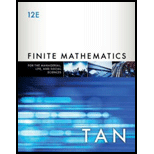
Finite Mathematics for the Managerial, Life, and Social Sciences
12th Edition
ISBN: 9781337405782
Author: Soo T. Tan
Publisher: Cengage Learning
expand_more
expand_more
format_list_bulleted
Concept explainers
Question
Chapter A.3, Problem 38E
To determine
(a)
To represent:
The statement “if the unemployment rate does not decrease, consumer confidence will not improve.” symbolically.
To determine
(b)
To represent:
The statement “Consumer confidence will improve if and only if the unemployment rate does not decrease.” symbolically.
To determine
(c)
To represent:
The statement “A decreasing unemployment rate is a sufficient condition for consumer confidence to improve.” symbolically.
To determine
(d)
To represent:
The statement “A decreasing unemployment rate is a necessary and sufficient condition for consumer confidence to improve.” symbolically.
Expert Solution & Answer
Want to see the full answer?
Check out a sample textbook solution
Students have asked these similar questions
2. Determine the validity of the following argument.
If the stock market rises, then the bond market will fall.
The bond market did not fall.
.. The stock market did not rise.
Let r represent "The stock market rises." Let f represent "The bond market will fall."
Formulate the following argument symbolically and determine whether each is
valid:
Let p: I study hard
q: I get an excellent grade
r: I get rich
1. If I study hard, then I get an excellent grade.
I study hard.
Therefore, I get an excellent grade.
2. If I study hard, then I get an excellent grade.
If I don't get rich, then I don't get an excellent grade.
Therefore, I get rich.
3. I study hard if and only if I get rich.
I get rich.
Therefore, I study hard.
4. If I study hard then I get an excellent grade or I get rich.
I don't get an excellent grade and I don't get rich.
Therefore, I don't study hard.
5. I get rich or I get and excellent grade.
I study hard.
Therefore, I don't get rich.
1. Determine which of the following are statements, and classify each statement as either true or false.
(a) President George Washington was born in (e) Close the door.
Alabama.
(1) 2.3=7.
(g) 3x = 6.
(h) Help stop inflation.
(b) Good morning.
(c) 5+4=9.
(d) x+5=8.
2. Ifp is T and q is F, find the truth values of these statements. The form~() represents the negation of
everything inside the parentheses.
(a) (~p) ^q
(b) (~p) v (~q)
(c) ~(pvq)
3.
Find the truth values of the statements in Exercise 2 if p is T and q is T.
4. Find the truth values of the statements in Exercise 2 if p is F and q is F.
5.
In each of the parts that follow, construct two statements-one using and and the other using or-and
find the truth values of each.
(d) ~ (p ^ q)
(e) ~[(~p) ^q]
(f) ~(pv~q)
(a) November has 30 days. Thanksgiving is always on November 25.
(b) The smallest counting number is 2. 10 is not a multiple of 5.
(c) 2+3=4+1.
8.6 4.12.
(d) Triangles are not squares. 3 is smaller than 5.
6. Translate…
Chapter A Solutions
Finite Mathematics for the Managerial, Life, and Social Sciences
Ch. A.1 - In Exercises 114, determine whether the statement...Ch. A.1 - In Exercises 114, determine whether the statement...Ch. A.1 - Prob. 3ECh. A.1 - Prob. 4ECh. A.1 - Prob. 5ECh. A.1 - Prob. 6ECh. A.1 - Prob. 7ECh. A.1 - Prob. 8ECh. A.1 - Prob. 9ECh. A.1 - Prob. 10E
Ch. A.1 - Prob. 11ECh. A.1 - Prob. 12ECh. A.1 - Prob. 13ECh. A.1 - Prob. 14ECh. A.1 - Prob. 15ECh. A.1 - Prob. 16ECh. A.1 - Prob. 17ECh. A.1 - Prob. 18ECh. A.1 - Prob. 19ECh. A.1 - Prob. 20ECh. A.1 - Prob. 21ECh. A.1 - Prob. 22ECh. A.1 - Prob. 23ECh. A.1 - Prob. 24ECh. A.1 - Prob. 25ECh. A.1 - Prob. 26ECh. A.1 - Prob. 27ECh. A.1 - Prob. 28ECh. A.1 - Prob. 29ECh. A.1 - Let p and q denote the propositions p: The...Ch. A.1 - Prob. 31ECh. A.1 - Prob. 32ECh. A.1 - Prob. 33ECh. A.2 - Prob. 1ECh. A.2 - Prob. 2ECh. A.2 - Prob. 3ECh. A.2 - Prob. 4ECh. A.2 - In Exercises 1-18, construct a truth table for...Ch. A.2 - Prob. 6ECh. A.2 - Prob. 7ECh. A.2 - In Exercises 1-18, construct a truth table for...Ch. A.2 - Prob. 9ECh. A.2 - Prob. 10ECh. A.2 - Prob. 11ECh. A.2 - Prob. 12ECh. A.2 - Prob. 13ECh. A.2 - Prob. 14ECh. A.2 - Prob. 15ECh. A.2 - Prob. 16ECh. A.2 - Prob. 17ECh. A.2 - Prob. 18ECh. A.2 - If a compound proposition consists of the prime...Ch. A.3 - In Exercises 14, write the converse, the...Ch. A.3 - In Exercises 14, write the converse, the...Ch. A.3 - Prob. 3ECh. A.3 - Prob. 4ECh. A.3 - Prob. 5ECh. A.3 - In Exercises 5 and 6, refer to the following...Ch. A.3 - Prob. 7ECh. A.3 - Prob. 8ECh. A.3 - Prob. 9ECh. A.3 - Prob. 10ECh. A.3 - Prob. 11ECh. A.3 - Prob. 12ECh. A.3 - Prob. 13ECh. A.3 - Prob. 14ECh. A.3 - Prob. 15ECh. A.3 - Prob. 16ECh. A.3 - Prob. 17ECh. A.3 - Prob. 18ECh. A.3 - Prob. 19ECh. A.3 - Prob. 20ECh. A.3 - Prob. 21ECh. A.3 - Prob. 22ECh. A.3 - Prob. 23ECh. A.3 - Prob. 24ECh. A.3 - Prob. 25ECh. A.3 - Prob. 26ECh. A.3 - Prob. 27ECh. A.3 - Prob. 28ECh. A.3 - Prob. 29ECh. A.3 - Prob. 30ECh. A.3 - Prob. 31ECh. A.3 - Prob. 32ECh. A.3 - Prob. 33ECh. A.3 - Prob. 34ECh. A.3 - Prob. 35ECh. A.3 - Prob. 36ECh. A.3 - Prob. 37ECh. A.3 - Prob. 38ECh. A.4 - Prove the idempotent law for conjunction, ppp.Ch. A.4 - Prob. 2ECh. A.4 - Prove the associative law for conjunction,...Ch. A.4 - Prob. 4ECh. A.4 - Prove the commutative law for conjunction, pqqp.Ch. A.4 - Prob. 6ECh. A.4 - Prob. 7ECh. A.4 - Prob. 8ECh. A.4 - Prob. 9ECh. A.4 - Prob. 10ECh. A.4 - Prob. 11ECh. A.4 - Prob. 12ECh. A.4 - Prob. 13ECh. A.4 - Prob. 14ECh. A.4 - Prob. 15ECh. A.4 - Prob. 16ECh. A.4 - Prob. 17ECh. A.4 - In exercises 9-18, determine whether the statement...Ch. A.4 - Prob. 19ECh. A.4 - Prob. 20ECh. A.4 - In Exercises 21-26, use the laws of logic to prove...Ch. A.4 - Prob. 22ECh. A.4 - In Exercises 21-26, use the laws of logic to prove...Ch. A.4 - In Exercises 21-26, use the laws of logic to prove...Ch. A.4 - In Exercises 21-26, use the laws of logic to prove...Ch. A.4 - Prob. 26ECh. A.5 - Prob. 1ECh. A.5 - Prob. 2ECh. A.5 - Prob. 3ECh. A.5 - Prob. 4ECh. A.5 - Prob. 5ECh. A.5 - Prob. 6ECh. A.5 - Prob. 7ECh. A.5 - Prob. 8ECh. A.5 - Prob. 9ECh. A.5 - In Exercises 116, determine whether the argument...Ch. A.5 - Prob. 11ECh. A.5 - Prob. 12ECh. A.5 - Prob. 13ECh. A.5 - Prob. 14ECh. A.5 - Prob. 15ECh. A.5 - Prob. 16ECh. A.5 - In Exercises 17-22, represent the argument...Ch. A.5 - Prob. 18ECh. A.5 - In Exercises 17-22, represent the argument...Ch. A.5 - In Exercises 17-22, represent the argument...Ch. A.5 - In Exercises 17-22, represent the argument...Ch. A.5 - Prob. 22ECh. A.5 - Prob. 23ECh. A.5 - Prob. 24ECh. A.5 - Prob. 25ECh. A.6 - In Exercises 1-5, find a logic statement...Ch. A.6 - Prob. 2ECh. A.6 - Prob. 3ECh. A.6 - Prob. 4ECh. A.6 - Prob. 5ECh. A.6 - Prob. 6ECh. A.6 - Prob. 7ECh. A.6 - Prob. 8ECh. A.6 - Prob. 9ECh. A.6 - Prob. 10ECh. A.6 - Prob. 11ECh. A.6 - Prob. 12ECh. A.6 - Prob. 13ECh. A.6 - In Exercise 12-15, find a logic statement...Ch. A.6 - Prob. 15ECh. A.6 - Prob. 16E
Knowledge Booster
Learn more about
Need a deep-dive on the concept behind this application? Look no further. Learn more about this topic, subject and related others by exploring similar questions and additional content below.Similar questions
- Complete the table by testing the validity of each argument using common patterns of reasoning All racers live dangerously. Gomer is a racer. Therefore, Gomer lives dangerously. 11. If you aren't polite, you won't be treated with respect. You aren't treated with respect. Therefore, you aren't polite. 12. If you are kind to a puppy, then he will be your friend. You weren't kind to that puppy. Hence, he isn't your friend. 13. If I don't pay my income taxes, then I file for an extension or I am a felon. I'm not a felon and I didn't file for an extension. Therefore, I paid my income taxes 14. I wash the dishes or I don't eat. I eat. Thus, I wash the dishes 15. If you play golf during a thunderstorm, you'll get hit by lightning. You didn't get hit by lightning. Therefore, you didn't play golf during a thunderstorm. 16. If an animal is a squid, then it has tentacles. If an animal is an octopus, then it has…arrow_forwardDetermine if the statements below are True or False. If it’s True, explain why. If it’s False,explain why not, or simply give an example demonstrating why it’s false. A correct choiceof ”True” or ”False” with no explanation will not receive any credit.arrow_forwardAfter the premiere of the new comedy Bumblebee, moviegoers we're asked in a quick poll whether they liked the movie. Out of 50 adults, all but 14 said they liked the movie, whereas out of 20 teenagers, all but 8 said they liked the movie. Fill in the blanks of the statement below to make the statement the most reasonable possible. At the movie premiere, _________ moviegoers liked the movie more because only _____% disliked the movie, whereas _____% of the ______ moviegoers disliked the movie.arrow_forward
- Identify each situation as INDUCTUVE or DEDUCTIVE REASONING and provide explanation/ the reason why it is inductive or deductive reasoning. Premise: All turtles have shells. Conclusion: I conclude that the animal in my bag has a shell. Premise: The animal I have captured is a turtle. Premise: Tonya is seen walking from her car to her home with a set of golf clubs. Conclusion: Tonya has bought the set of golf clubs for Jack. Premise: Tonya's husband Jeff loves golf and tomorrow is his birthday. Given: 5(x+2) = -3x - 6 ST 5 6. Prove: x = -27arrow_forward2). Write each symbolic statement in words. Use the variables m, n, and r as defined below. m: Stocks are increasing. n: Interest rates are steady. r: John will invest in stocks. a). ~n Vr I b). ~(m Vr)arrow_forwardExecutive: We recently ran a set of advertisements in the print version of a travel magazine and on that magazine's website. We were unable to get any direct information about the consumer response to the print ads. However, we found the consumer response to the ads on the website were much more limited than is typical for website ads. We concluded that the response to the print ads is below par as well. The executive's response does which one of the following? a. uses information about the typical frequency of events of a general kind about the probability of a particular event of that kind. b. bases a prediction of the phenomenon on the intensity of the phenomenon's cause C. uses a case in which direct information is available to draw conclusions about and analogous case in which direct evidence is unavailable. d. infers a statistical generalization from claims about a large number of specific instances.arrow_forward
- Write the contrapositive of the statement.If the magazine article is accurate, then stock prices are holding steady. If stock prices are not holding steady, then the magazine article is not accurate. If the magazine article is not accurate, then it is misleading. If stock prices are not holding steady, then the magazine article is accurate. If the magazine article is not accurate, then stock prices are not holding steady.arrow_forwardActivity 2: Inductive or Deductive Directions: Read the following statements carefully. Determine if the following argument is best classified as inductive or deductive. Write Inductive if inductive reasoning is used and Deductive for deductive reasoning. Write your answers in your answer sheet. 1. I heard lots of barking last night. The neighbor's dog must've been pretty upset about something, since he rarely barks. 2. All dogs bark. Fido is a dog, so he barks. 3. No book in English begins numbering its pages on a left-hand page. This is a book in English, therefore it will begin its numbering on a right-hand page. 4. On a National Geographic map, no two adjacent nations appear shaded with the same color. Brazil is shaded green on this map, and it is a National Geographic map. Only two nations in South America are not adiacent to Brazil. So, at most three South American nations on this map are shaded green. 5. The overwhelming majority of mutations are not beneficial to an organism's…arrow_forward
arrow_back_ios
arrow_forward_ios
Recommended textbooks for you
 Discrete Mathematics and Its Applications ( 8th I...MathISBN:9781259676512Author:Kenneth H RosenPublisher:McGraw-Hill Education
Discrete Mathematics and Its Applications ( 8th I...MathISBN:9781259676512Author:Kenneth H RosenPublisher:McGraw-Hill Education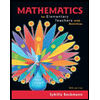 Mathematics for Elementary Teachers with Activiti...MathISBN:9780134392790Author:Beckmann, SybillaPublisher:PEARSON
Mathematics for Elementary Teachers with Activiti...MathISBN:9780134392790Author:Beckmann, SybillaPublisher:PEARSON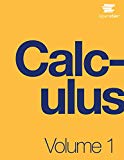
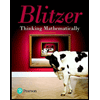 Thinking Mathematically (7th Edition)MathISBN:9780134683713Author:Robert F. BlitzerPublisher:PEARSON
Thinking Mathematically (7th Edition)MathISBN:9780134683713Author:Robert F. BlitzerPublisher:PEARSON Discrete Mathematics With ApplicationsMathISBN:9781337694193Author:EPP, Susanna S.Publisher:Cengage Learning,
Discrete Mathematics With ApplicationsMathISBN:9781337694193Author:EPP, Susanna S.Publisher:Cengage Learning,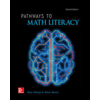 Pathways To Math Literacy (looseleaf)MathISBN:9781259985607Author:David Sobecki Professor, Brian A. MercerPublisher:McGraw-Hill Education
Pathways To Math Literacy (looseleaf)MathISBN:9781259985607Author:David Sobecki Professor, Brian A. MercerPublisher:McGraw-Hill Education

Discrete Mathematics and Its Applications ( 8th I...
Math
ISBN:9781259676512
Author:Kenneth H Rosen
Publisher:McGraw-Hill Education

Mathematics for Elementary Teachers with Activiti...
Math
ISBN:9780134392790
Author:Beckmann, Sybilla
Publisher:PEARSON


Thinking Mathematically (7th Edition)
Math
ISBN:9780134683713
Author:Robert F. Blitzer
Publisher:PEARSON

Discrete Mathematics With Applications
Math
ISBN:9781337694193
Author:EPP, Susanna S.
Publisher:Cengage Learning,

Pathways To Math Literacy (looseleaf)
Math
ISBN:9781259985607
Author:David Sobecki Professor, Brian A. Mercer
Publisher:McGraw-Hill Education
Propositional Logic, Propositional Variables & Compound Propositions; Author: Neso Academy;https://www.youtube.com/watch?v=Ib5njCwNMdk;License: Standard YouTube License, CC-BY
Propositional Logic - Discrete math; Author: Charles Edeki - Math Computer Science Programming;https://www.youtube.com/watch?v=rL_8y2v1Guw;License: Standard YouTube License, CC-BY
DM-12-Propositional Logic-Basics; Author: GATEBOOK VIDEO LECTURES;https://www.youtube.com/watch?v=pzUBrJLIESU;License: Standard Youtube License
Lecture 1 - Propositional Logic; Author: nptelhrd;https://www.youtube.com/watch?v=xlUFkMKSB3Y;License: Standard YouTube License, CC-BY
MFCS unit-1 || Part:1 || JNTU || Well formed formula || propositional calculus || truth tables; Author: Learn with Smily;https://www.youtube.com/watch?v=XV15Q4mCcHc;License: Standard YouTube License, CC-BY